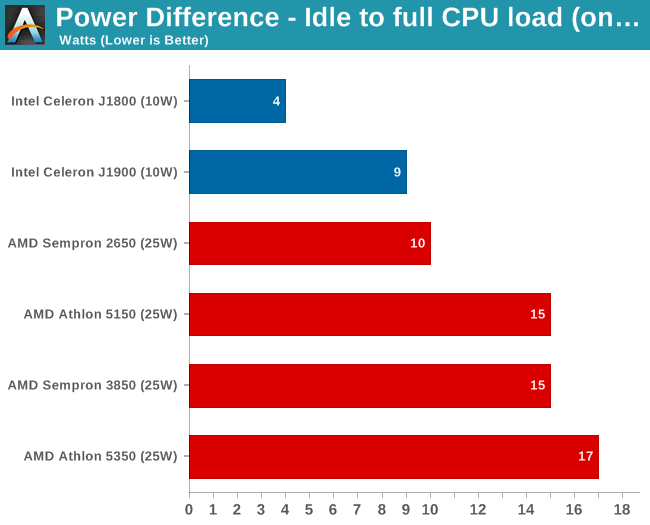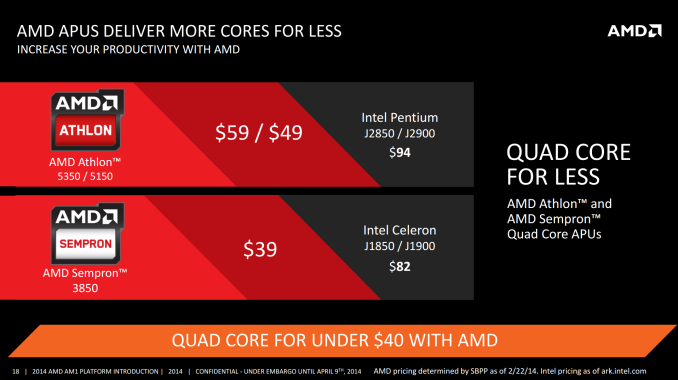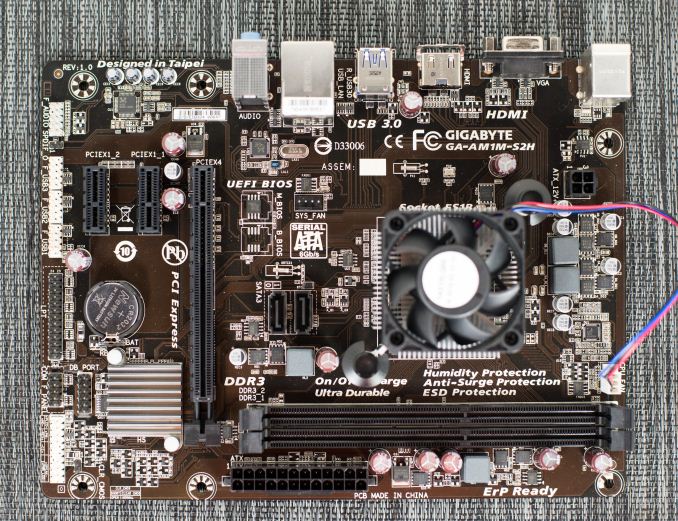AMD AM1 Kabini Part 2: Athlon 5350/5150 and Sempron 3850/2650 Tested
by Ian Cutress on May 29, 2014 2:00 PM ESTThe Competition
Because AMD is the first x86 CPU manufacturer to move their tablet focused processors into the socketed market along with low-cost motherboards, Intel has no direct comparative product. We have to look to their Bay Trail-D SoC range which loses that upgradable functionality. Competition between AMD and Intel on this front is a tit-for-tat operation, with each company focusing on their different strengths. AMD’s integrated IGP aims to be more powerful than the equivalent Intel along with support for DDR3-1600 memory, as well as cheaper overall, however Intel can boast dual channel memory and a lower power output.
With all these differences between Kabini and Bay Trail, including price, power and cores/threads, it is hard to find Intel parts that accurately match each other. AMD has put the following in front of reviewers to provide a guide:
AMD consider the Athlon 5350/5150 parts (quad core, 2.05 GHz and 1.6 GHz) in line with the Intel Pentium J2850/J2900, and the Sempron 3850 with the J1850/J1900. For this Part 2 we were able to obtain full Celeron J1800 (dual core) and Celeron J1900 (quad core) Bay Trail-D parts for testing. Even though AMD puts the Athlon 5350 in the path of the J2900, the J2900 is primarily an OEM solution used by Acer. A single J2900 motherboard appeared on Newegg a week after we had packed up testing.
In fact, I think the 5350 vs the J1900 is a better fit:
| AMD Athlon 5350 vs. Intel Celeron J1900 | ||||
| Athlon 5350 | Celeron J1900 | |||
| CPU Architecture | Jaguar | Silvermont | ||
| CPU Cores | 4 | 4 | ||
| CPU Frequency | 2.05 GHz | 2.0 GHz / 2.4 GHz Turbo | ||
| GPU Cores | 128 SPs | 6 EUs | ||
| GPU Frequency | 600 MHz | 688 MHz | ||
| Memory Channels | Single | Dual | ||
| Memory Frequency | 1600 MHz | 1333 MHz | ||
| L2 Cache | 2 MB | 2 MB | ||
| TDP | 25 W | 10 W | ||
| Price | $59 | $82 | ||
Also we can now directly compare pricing. Take for example the two of the motherboards we had for this review, one J1900 and the other AM1 while equipping the system with an Athlon 5350:
GIGABYTE J1900N-D3V: $87 (Newegg)
GIGABYTE AM1M-S2H: $35 (Newegg)
AMD Athlon 5350: $65 (Newegg)
Totaling up the AMD components gives $100 vs $87 from Newegg, or £65 vs. £66 on Amazon UK, on the extreme high end of a Kabini AM1 setup. Pricing is also influenced slightly by quoting the boxed version of the APU, rather than the OEM pricing that AMD likes to quote.
Our test setup is a follows:
| Test Setup | |
| CPU | AMD Athlon 5350, Quad Core, 2.05 GHz |
| AMD Athlon 5150, Quad Core, 1.60 GHz | |
| AMD Sempron 3850, Quad Core, 1.30 GHz | |
| AMD Sempron 2650, Dual Core, 1.45 GHz | |
| Motherboard | GIGABYTE AM1M-S2H |
| Memory | 2x4GB DDR3-1600 9-10-10 |
| SSD | OCZ Vertex 3 |
| Power Supply | OCZ 1250W ZX Series |
| Graphics | Integrated |
| Graphics Drivers | 14.3 Beta |
Note that for our benchmark results we are also taking data from previous reviews done at AnandTech, including some of the higher powered mainstream systems. Over time we have added benchmarks (such as SYSmark 2014) which are lacking some of the mid-range data.
Power Consumption: Idle to 100% CPU Load (on IGP)

Because of the difference in TDP, the AMD APUs here use more energy, although all four comfortably use less than the 25W TDP. The dual core especially only registered a 10W difference from idle to a full CPU load.













87 Comments
View All Comments
Ian Cutress - Thursday, May 29, 2014 - link
I've taken test data from all of my old testing as well, where I've run the same benchmarks on the same OS and SSD, hence why there are many data points to choose from. I have adjusted several of the graphs to have a narrower band of data showing to more easily see the difference now. Unfortunately the even older data (pre Core 2) is before my time at AnandTech.Regarding the J1800/J1900 motherboards, the two that I hurried in for testing were unfortunately limited in the GPU aspect and a third one I have since received is also in the same boat. Due to the hurried nature of getting the data from the initial release (as well as other testing on hand) I had perhaps wrongly assumed that all J1800/J1900 motherboards were in the same boat.
I am shifting my test stations around somewhat this week, so when I come back from Computex I will have more of a low power/DRAM testing setup alongside the higher power systems I normally test. If you want to see anything specific, please feel free to email.
edwpang - Friday, May 30, 2014 - link
It's definitely makes better sense than current review. As someone has already, using 1250w PS on this low end setup is kindly uselessly.piroroadkill - Thursday, May 29, 2014 - link
Truecrypt link seems like a bad idea right now, since the official Truecrypt site is in a terrible state of limbo where nobody can figure out whether it's discontinued by the devs or been hacked. Benchmarks for 7.1a are relevant, but 7.2 is a gutted, useless pile of crap. Just saying.A5 - Thursday, May 29, 2014 - link
It's good thing the bench is 7.1a then?Ian Cutress - Thursday, May 29, 2014 - link
Ha! I thought about taking the data out given that I had already uploaded almost all it before that announcement was made. However 7.1a is still viable and I still have the installer, so it might still be relevant if the installer still floats around in cyberspace. I somehow doubt we will ever get a full explanation from the developers on why they took it down, though there are many theories about it.Runamok81 - Thursday, May 29, 2014 - link
Typo, second to last sentence. platgormsomeeeguy - Thursday, May 29, 2014 - link
Ian, in the "dGPU Benchmarks with ASUS HD7970" portion of your review, it would have been interesting to see some Mantle results on these low power CPUs.JBVertexx - Thursday, May 29, 2014 - link
I think the value in having a socket solution is less about providing an upgrade path and more about lower carrying costs in the entire supply chain.If you look at having 4 CPU combinations over lets say 4 motherboard options, having a BGA solution means that you need to source and stock 16 different items. With a socket solution, that cuts your inventory and carrying cost down to 8 items.
The economics of this are huge. It impacts motherboard manufacturers, system builders, and businesses. It impacts the amount of up front investment required by every organization in the supply chain, and it impacts the inventory costs (or carrying capital).
It especially impacts motherboard manufacturers, who must actually purchase the CPU in a BGA solution in order to sell a motherboard.
In the face of those compelling economics, having an upgrade path is really small potatoes.
marvee - Thursday, May 29, 2014 - link
The understanding of those economics could be the experience of Rory Read, from his time with Lenovo.Hrel - Thursday, May 29, 2014 - link
Pretty disappointing you guy didn't include a CPU with HD4600 on it in the gaming benchmarks. Why compare to last generation's hardware? Perhaps to show AMD in as favorable a light as possible? hmmmmm.....